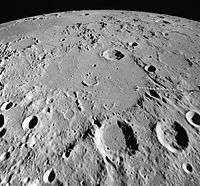Hipparchus (lunar crater)
|
The lunar crater Hipparchus lies in the middle of this image. NASA photo. | |
| Coordinates | 5°30′S 4°48′E / 5.5°S 4.8°ECoordinates: 5°30′S 4°48′E / 5.5°S 4.8°E |
|---|---|
| Diameter | 150 km |
| Depth | 3.3 km |
| Colongitude | 354° at sunrise |
| Eponym | Hipparchus |
Hipparchus is the degraded remnant of a lunar crater. It is located to the southeast of Sinus Medii, near the center of the visible Moon. To the south is the prominent crater Albategnius, and to the southwest lies Ptolemaeus, a feature of comparable dimensions to Hipparchus. Horrocks lies entirely within the northeast rim of the crater. Halley is attached to the south rim, and Hind lies to the southeast. To the north-northeast is the bowl-shaped Pickering, and the flooded Saunder is located off the northeast rim.
High-resolution images of Hipparchus were obtained by Lunar Orbiter 5 in 1967.
Description
This feature is an ancient crater that has been subject to considerable modification due to subsequent impacts. The western rim of Hipparchus has been all but worn away from impact erosion, and only low hills and rises in the surface remain to outline the feature. The wall to the east is somewhat more intact, but it too is heavily worn. A pair of deep clefts lie in the western wall. These parallel a sets of scars running through the south-central highlands.
The crater floor has been partially resurfaced by basaltic lava flow. The southwest part of the floor, however, is slightly raised and much more rugged than the remainder. A few small rises and the raised partial rim of a flooded crater are all that remain of a central massif.
Gaps in the northwest rim of Hipparchus form valleys that connect with the mare to the northwest. A rille named Rima Réaumur runs from this site to the outer wall of Réaumur.
Satellite craters
By convention these features are identified on lunar maps by placing the letter on the side of the crater midpoint that is closest to Hipparchus.
| Hipparchus | Latitude | Longitude | Diameter |
|---|---|---|---|
| B | 6.9° S | 1.7° E | 5 km |
| C | 7.3° S | 8.2° E | 17 km |
| D | 4.5° S | 2.1° E | 5 km |
| E | 4.2° S | 2.3° E | 5 km |
| F | 4.2° S | 2.5° E | 9 km |
| G | 5.0° S | 7.4° E | 15 km |
| H | 5.4° S | 2.3° E | 5 km |
| J | 7.6° S | 3.2° E | 14 km |
| K | 6.9° S | 2.2° E | 12 km |
| L | 6.8° S | 9.0° E | 13 km |
| N | 4.8° S | 5.0° E | 6 km |
| P | 4.7° S | 2.8° E | 5 km |
| Q | 8.5° S | 2.9° E | 8 km |
| T | 7.1° S | 3.6° E | 8 km |
| U | 6.7° S | 3.6° E | 8 km |
| W | 5.0° S | 7.8° E | 5 km |
| X | 5.7° S | 4.9° E | 17 km |
| Z | 8.5° S | 9.1° E | 6 km |
Hipparchus in fiction
In the French version of the Tintin book Explorers on the Moon (On a marché sur la lune), the crew lands on Hipparchus.[1]
External links
Lunar Orbiter 5 frames of the interior of Hipparchus: 5098, 5099, 5100, 5101
References
- ↑ éd. Casterman, coll. Tintin, 1954 (French)
- Andersson, L. E.; Whitaker, E. A. (1982). NASA Catalogue of Lunar Nomenclature. NASA RP-1097.
- Blue, Jennifer (July 25, 2007). "Gazetteer of Planetary Nomenclature". USGS. Retrieved 2007-08-05.
- Bussey, B.; Spudis, P. (2004). The Clementine Atlas of the Moon. New York: Cambridge University Press. ISBN 978-0-521-81528-4.
- Cocks, Elijah E.; Cocks, Josiah C. (1995). Who's Who on the Moon: A Biographical Dictionary of Lunar Nomenclature. Tudor Publishers. ISBN 978-0-936389-27-1.
- McDowell, Jonathan (July 15, 2007). "Lunar Nomenclature". Jonathan's Space Report. Retrieved 2007-10-24.
- Menzel, D. H.; Minnaert, M.; Levin, B.; Dollfus, A.; Bell, B. (1971). "Report on Lunar Nomenclature by the Working Group of Commission 17 of the IAU". Space Science Reviews. 12 (2): 136–186. Bibcode:1971SSRv...12..136M. doi:10.1007/BF00171763.
- Moore, Patrick (2001). On the Moon. Sterling Publishing Co. ISBN 978-0-304-35469-6.
- Price, Fred W. (1988). The Moon Observer's Handbook. Cambridge University Press. ISBN 978-0-521-33500-3.
- Rükl, Antonín (1990). Atlas of the Moon. Kalmbach Books. ISBN 978-0-913135-17-4.
- Webb, Rev. T. W. (1962). Celestial Objects for Common Telescopes (6th revised ed.). Dover. ISBN 978-0-486-20917-3.
- Whitaker, Ewen A. (1999). Mapping and Naming the Moon. Cambridge University Press. ISBN 978-0-521-62248-6.
- Wlasuk, Peter T. (2000). Observing the Moon. Springer. ISBN 978-1-85233-193-1.
